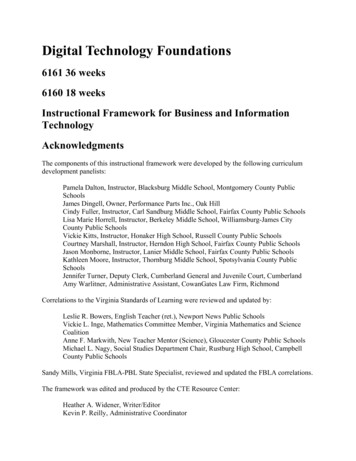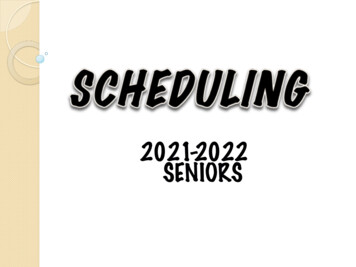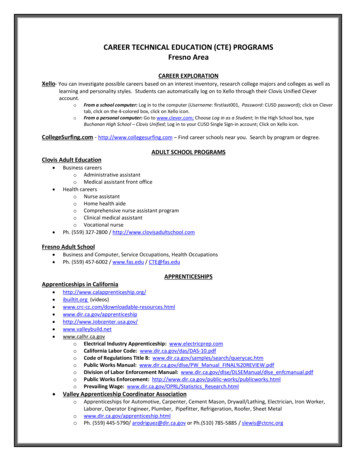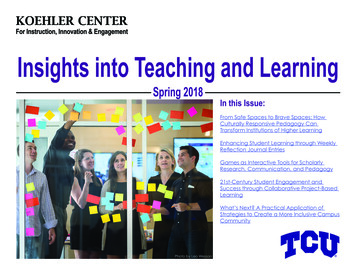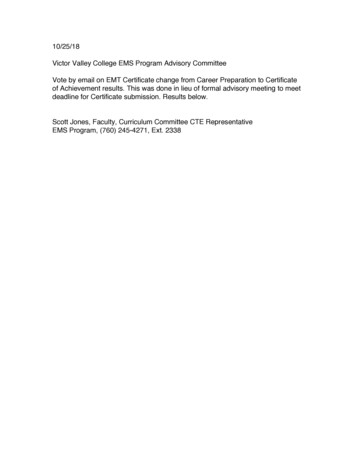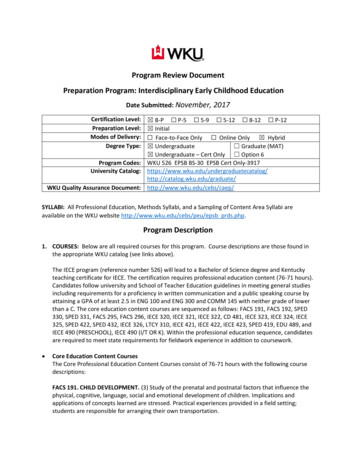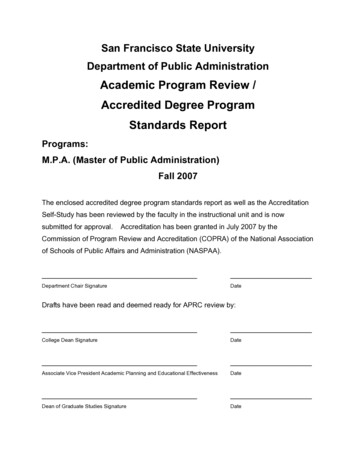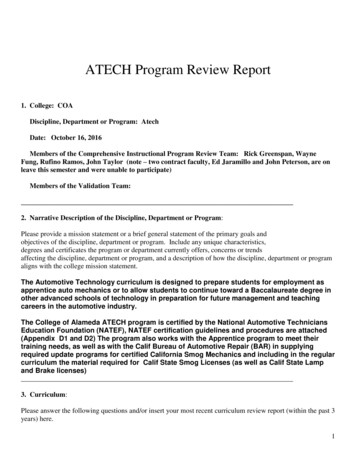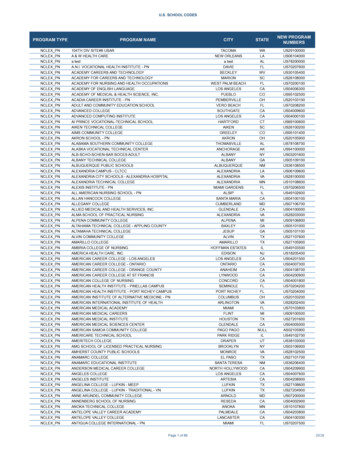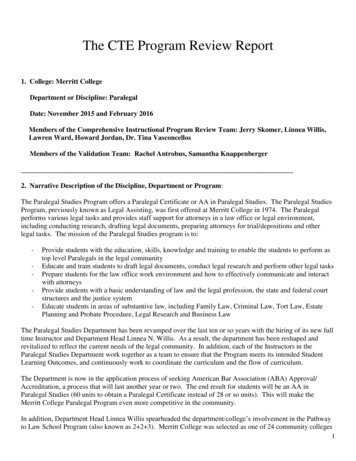
Transcription
The CTE Program Review Report1. College: Merritt CollegeDepartment or Discipline: ParalegalDate: November 2015 and February 2016Members of the Comprehensive Instructional Program Review Team: Jerry Skomer, Linnea Willis,Lawren Ward, Howard Jordan, Dr. Tina VasconcellosMembers of the Validation Team: Rachel Antrobus, Samantha Knappenberger2. Narrative Description of the Discipline, Department or Program:The Paralegal Studies Program offers a Paralegal Certificate or AA in Paralegal Studies. The Paralegal StudiesProgram, previously known as Legal Assisting, was first offered at Merritt College in 1974. The Paralegalperforms various legal tasks and provides staff support for attorneys in a law office or legal environment,including conducting research, drafting legal documents, preparing attorneys for trial/depositions and otherlegal tasks. The mission of the Paralegal Studies program is to:-Provide students with the education, skills, knowledge and training to enable the students to perform astop level Paralegals in the legal communityEducate and train students to draft legal documents, conduct legal research and perform other legal tasksPrepare students for the law office work environment and how to effectively communicate and interactwith attorneysProvide students with a basic understanding of law and the legal profession, the state and federal courtstructures and the justice systemEducate students in areas of substantive law, including Family Law, Criminal Law, Tort Law, EstatePlanning and Probate Procedure, Legal Research and Business LawThe Paralegal Studies Department has been revamped over the last ten or so years with the hiring of its new fulltime Instructor and Department Head Linnea N. Willis. As a result, the department has been reshaped andrevitalized to reflect the current needs of the legal community. In addition, each of the Instructors in theParalegal Studies Department work together as a team to ensure that the Program meets its intended StudentLearning Outcomes, and continuously work to coordinate the curriculum and the flow of curriculum.The Department is now in the application process of seeking American Bar Association (ABA) Approval/Accreditation, a process that will last another year or two. The end result for students will be an AA inParalegal Studies (60 units to obtain a Paralegal Certificate instead of 28 or so units). This will make theMerritt College Paralegal Program even more competitive in the community.In addition, Department Head Linnea Willis spearheaded the department/college’s involvement in the Pathwayto Law School Program (also known as 2 2 3). Merritt College was selected as one of 24 community colleges1
throughout the state as part of a program to increase diversity to law school. As a result, if students take 7 or socourses at Merritt College, they will ultimately be able to have admission to the participating law schools (SantaClara University, University of San Francisco, UC Davis, UC Irvine, University of Southern California (USC),Loyola). This is a great growth opportunity for Merritt College and the Paralegal Studies Program.Further, Department Head Linnea Willis has led the Public Law & Safety portion of the Career Pathways Trustand creating course pathways from the high schools to law schools – including individual coursearticulation/agreements, and also working on developing pathways to complete ½ or more of the paralegalstudies requirements while in high school. So this will also add additional students to the classroom.These are just some of the new and innovative developments to the Paralegal Department.3. Curriculum:Please answer the following questions and/or insert your most recent curriculum review report (withinthe past 3 years) here.Attach the Curriculum Review Report or Answer these Questions:- PENDING Have all of your course outlines of record been updated or deactivated in the past three years? Ifnot, list the courses that still need updating and specify when your department will update eachone, within the next three years.No. Most of the Courses have not been updated in the last three years, even though updated in the lastfive or so years. The Department is taking steps now to ensure that each of the course outlines areupdated and has already been in communication with the Curriculum Committee to ensure this occursand to determine course update priorities. These updates will be completed by Spring or Fall 2016. What are the discipline, department or program of study plans for curriculum improvement (i.e.,courses or programs to be developed, enhanced, or deactivated)?Program Improvement Plan #1: Create an AA-Transfer degree so that the courses are transferrable;by most likely changing the program to Legal Studies rather than Paralegal Studies in order to articulateto the CSU, UC and various private schools.Program Improvement Plan #2: ABA Accreditation – As a result of obtaining ABA Accreditation,additional legal studies courses will be added as set forth below, and the program will be improved.Program Improvement Plan #3: Develop and market the Pathway to Law School Program, so thatadditional students will take Paralegal classes as a result.Program Improvement Plan #4:Create a Pre-Law Certificate (and AA) in conjunction with theParalegal Program and Pathway to Law School Program, to market even more to those who want toattend law school.Improvement Plan #5: Purchase Law Office Technology to enhance courses and allow students to havetraining on law office technology in classroom – calendaring, billing, timekeeping, case management,etc.2
Improvement Plan #6: Pay for all the professors to attend training to get unique teaching techniques inspecific paralegal courses, by attending the American Association for Paralegal Educators (AAfPE)ConferencesCourses to Be Enhanced as Distance Education/Online/Hybrid Courses: Since the last ProgramReview, Professors Lawren Ward and Linnea Willis took Online Course training. As such, the courseoutlines are being updated to include DE Addendums such that courses can be offered as hybrid coursesand/or online courses. This will be added as an option for each of the Paralegal courses.Courses to Be Developed:1) Street Law incorporated into PARLG 1 Intro to Law as part of the Pathway to Law SchoolRequirements2) Argumentation class incorporated into the Paralegal Studies Department and Certificate, also as partof the Pathway to Law School Requirements3) Service Learning incorporated into COPED 474A or its own class, into the Paralegal StudiesDepartment and Certificate, also as part of the Pathway to Law School Requirements3) Business Law as a new Paralegal course, so that students have the option to take Business Law fromParalegal professors/attorneys rather than from the Business Department4) Various Other subjects will hopefully be added upon obtaining ABA Accreditation, including but notlimited to: Law Office Technology, Ethics, Intellectual Property Law, Employment Law, ImmigrationLaw and other courses Please list your degrees and/or certificates. Can any of these degrees and/or certificates becompleted through Distance Education (50% or more of the course online)? Which degree orcertificate?The current degrees and certificates offered are as follows:Certificate in Paralegal StudiesAA in Paralegal StudiesNone of these degrees/certificates can be completed through Distance Education at this time, but asstated above, all of the courses are being updated so that they can be offered as hybrid or online in thefuture, a significant portion of the courses will be offered as a hybrid (or online) course option in thefuture, for many of the classes taught by Linnea Willis and Lawren Ward.3
4. Assessment:Please answer the following questions and attach the TaskStream “At a Glance” report for yourdiscipline, department, or program for the past three years Please review the “At a Glance” reports andanswer the following questions.See attached reports – Paralegal Program Assessment Cycle Summary Report and Next Steps ForImprovement PrintoutsQuestions: How does your discipline, department or program ensure that students are aware of the learningoutcomes of the courses and instructional programs in which they are enrolled? Where are yourdiscipline, department or program course and program SLOs published? (For example: syllabi,catalog, department website, etc. If they are on a website, please include a live link to the pagewhere they can be found)SLO’s are published in the Syllabi for every Paralegal course. Program Learning Outcomes arepublished in the catalog. See below for Paralegal Program Outcomes and how each course aligns withthe Program Outcomes.The faculty in the Paralegal Studies Department have worked extremely hard to ensure that the StudentLearning Outcomes are incorporated into the curriculum. First, the Paralegal Studies Department Headhas served on the Student Learning Outcomes and Assessment Committee and been very active inassisting the Paralegal Studies Departments and other departments with developing and incorporatingtheir Student Learning Outcomes. In addition, Program Student Learning Outcomes have beendeveloped, and each class has been aligned with the Program Learning Outcomes. Further, the ParalegalDepartment faculty have already done assessment of the Program outcomes, by assessing student workand whether or not the program outcomes are being met. The Paralegal Department faculty further havecontinuous discussion on how to improve teaching methods to ensure optimal student learning. Briefly describe at least three of the most significant changes/improvements your discipline,department or program made in the past three years as a response to course and programassessment results. Please state the course number or program name and assessment cycle (year)for each example and attach the data from the “Status Report” section of TaskStream for thesefindings.Improvement 1. Continuous Coordination By All of the Paralegal Professors – As a result ofCourse and Program assessment results, Professors are more in communication and better coordinateassignments in the introduction and advanced courses. For example, Instructors for Parlg 6 (LegalResearch – taught by Prof. Willis) and Parlg 11 (Advance Legal Research and Writing – taught by Prof.Ward) use the same book, and coordinate which research techniques are learned at the intro level andcarried over to the advanced level. For example, Instructors for Parlg 11 and Parlg 8 (Civil Procedure &Litigation – taught by Prof. Willis) coordinate writing assignments and motion assignments, so thatstudents taking the courses at the same time are learning the same writing techniques and information atthe same time, and able to apply the same instructions to assignments in both classes. By reviewingwork and assignments from all courses and having continuous Department Meetings with the ParalegalProfessors, the professors are able to better coordinate and improve learning.4
Improvement 2. ABA Accreditation Process – As a result of assessment results, the Department isseeking ABA Approval/Accreditation to increase enrollment of students to the program, and to improvestudent success in obtaining jobs in the workplace (from those employers who only hire persons whoattended an ABA accredited Paralegal Program).Improvement 3. Specific Training for Paralegal Educators – Professor Linnea Willis has attendedthe conference put on by the American Association for Paralegal Educators (AAfPE), an organization toimprove teaching specifically for paralegal studies educators. This has led to improved teachingtechniques and methods throughout the department. But funds are needed so that all of the professorscan attend rather than just one.Improvement 4. Hiring of a Student Worker Tutor – An additional improvement important to notethat resulted from assessment/departmental meetings: the hiring of a tutor to assist the paralegalstudents. This has been vital. Briefly describe three of the most significant examples of your discipline, department or programplans for course and /or program level improvement for the next three years as result of what youlearned during the assessment process. Please state the course number or program name andattach the data from the “Assessment Findings and Action Plan” section for each example.Plan 1. Obtain ABA Approval/Accreditation as set forth abovePlan 2. Change the Program to Legal Studies rather than Paralegal Studies and create/articulatean AA Transfer degree so that an AA in Paralegal Studies is transferrable.Plan 3. Finish Remodeling of Computer Lab P218. Paralegal Department had money set asidepreviously to remodel P218 – to rewire the classroom, to change the desks to face the front instead of thesides, and to add new furniture. Part of the rewiring was done, but nothing else was completed. Thiswas around the time that the classroom was made the largest SmartClassroom on campus and turned intoa SmartClassroom. Describe how assessment results for Distance Education courses and/or programs compare to theresults for the corresponding face-to-face classes.Not applicable at this time. Describe assessment results for courses with multiple sections. Are there similar results in eachsection?Yes. At this time courses with multiple courses are taught by the same professors. However, the resultsfor each section are similar. Describe your discipline, department or program participation in assessment of institutional leveloutcomes (ILOs).5
Each of the Program Outcomes align with the Institutional Learning Outcomes. How are your course and/or program level outcomes aligned with the institutional level outcomes?Please describe and attach the “Goal Alignment Summary” from TaskStream.The Paralegal Studies Department has 5 very strong Program outcomes that align directly with theinstitutional outcomes. In addition, as stated above, the Paralegal Studies Department faculty have takensignificant steps to ensure the program outcomes are being achieved, and continuously changingmethods of teaching/projects to ensure the outcomes are met/to ensure optimal student learning.See attached Program Map6
5. Instruction: Describe effective and innovative strategies used by faculty to involve students in the learningprocess.o Instructors use various effective and innovative strategies to involve students in the learning process,including guest speakers, demonstrative videos, requiring the students to participate in various handson activities and projects, continuous use of the computer lab, taking them outside of the classroomto the Law Library and courtrooms, and various other strategies. How has new technology been used by the discipline, department or program to improve studentlearning?o Each of the classrooms is now a Smart Classroom with Eno Boards, overhead projectors, audiospeaker system, and DVD/VCR equipment.o Students are exposed to various different teaching methods by the different faculty to involvestudents in the learning process, including but not limited to: collaborative projects, teamwork,presentations, using/conducting research using internet-based legal databases such as Lexis Nexis,contacting attorneys in the community, quizzes, assignments that involve actual assignments/projectsParalegals will perform as Paralegals in the legal community, and that involve using wordprocessing programs and computerso Technology is used to improve student learning – including Eno Boards, overhead projectors, the useof a computer classroom to allow students to conduct online research and utilize legal programs suchas billing/timekeeping programs and legal form programs.o Where appropriate, students are given assignments that require them to access Internet-based legaldatabases. These assignments require not only simple searches for various routine legal matters (e.g.finding specific legal statures, forms, etc.) but also some modest legal research and analyticalsynthesis.o The main classroom used for Paralegal Classes – P218 – is the largest computer lab and largestSmartClassroom on campus, and is utilized by Paralegal students to complete writing assignments,research assignments and to conduct legal research How does the discipline, department, or program maintain the integrity and consistency ofacademic standards with all methods of delivery, including face to face, hybrid, and DistanceEducation courses?o The Paralegal Studies Department maintains its integrity and consistency of academic standardswithin the discipline by having regular meetings with all faculty to discuss teaching methods, toassist each other, and to ensure consistency/coordination between the courses.o Faculty also share course outlines and syllabi and coordinate assignments/projects as much aspossible to ensure maximum student development and progress.7
How do you ensure that Distance Education classes have the same level of rigor as thecorresponding face-to-face classes?Not applicable at this time. Briefly discuss the enrollment trends of your discipline, department or program. Include thefollowing:o Overall enrollment trends in the past three yearsIn general, enrollment for the entire college has been declining over the past 3 years, and theParalegal Studies Department has also experienced that decline. There are several ideasaddressed below that also contribute to the decline in the enrollment specific to the ParalegalDepartment (lack of marketing support, loss of the website, etc.) that can be addressed andimproved with additional support and resources as addressed below.2012 Fall2013Spring157151Age2012 235-544055-6465 & AboveGrand TotalPARLGEthnicityAmericanIndian/Alaskan Native2013 Fall2014Spring2014 Fall2015Spring1471291131192013 Fall2014Spring2014 2417151623121571511471292012 Fall2013Spring2013 Fall2014Spring141131192014 Fall2015Spring1Asian111314111210Black/African 1922Multiple211215131320Other Non white11111Pacific IslanderUnknown/NonRespondent222219108449White Non Hispanic192815161612Grand %33%-28%-21%%ChangeAverage %-21%-50%8
Gender2012 Fall2013Spring2013 Fall2014Spring2014 Unknown111212943Grand geFallSpring-21%-23%-36%17%-64%-75%-28%-21%PARLG Fall EnrollmentsPARLG1571471132012 Fall2013 Fall2014 Fallo An explanation of student demand (or lack thereof) for specific courses.No lack for specific courses is known at this time.o Productivity for the discipline, department, or program compared to the collegeproductivity 14FALL2015SPRINGPARLG 1 - LAW/LEGAL PROFESSION20.0016.5015.5011.7510.7520.50PARLG 10 - FAMILY LAW26.00NA24.50NA23.00NAPARLG 11 - ADV LEGAL 7.00NA21.00PARLG 12 - ESTATE PLANNING17.517.517.59
PARLG 15 - CRIMINAL LAW25.50NA28.00NA15.50NAPARLG 16 - SEMINAR/PARLG INTERNSHIP8.5010.999.4912.997.509.49PARLG 4 - LAW OFFICE MGMT18.5015.5023.0117.0013.5014.63PARLG 6 - LEGAL RESEARCH15.7512.5014.7511.8411.5014.00PARLG 8 - CIVIL .00NA20.50PARLG 9 - INTRO TO TORT LAWCollege productivity rate (see 5.00Target0.00In general, enrollment for the entire college has been declining over the past 3 y
Loyola). This is a great growth opportunity for Merritt College and the Paralegal Studies Program. Further, Department Head Linnea Willis has led the Public Law & Safety portion of the Career Pathways Trust . Paralegal Program and Pathway to Law
